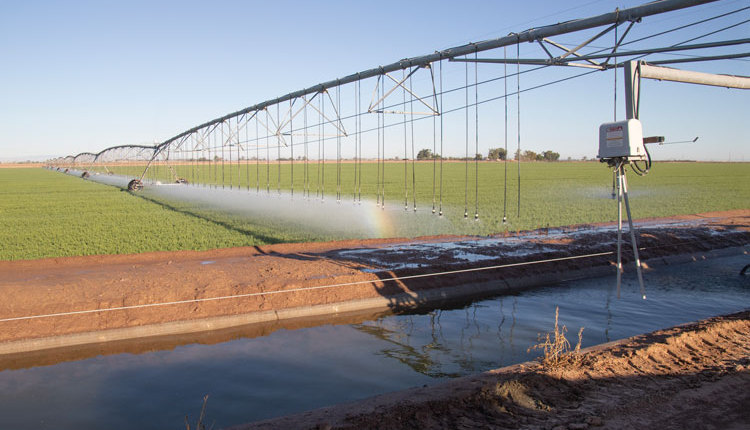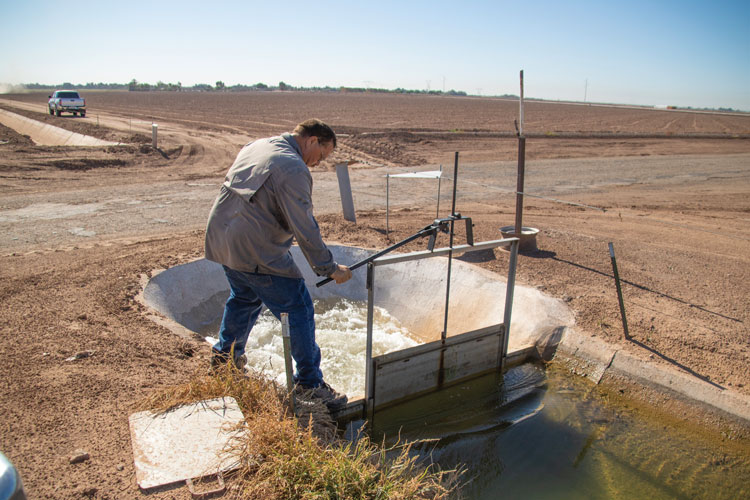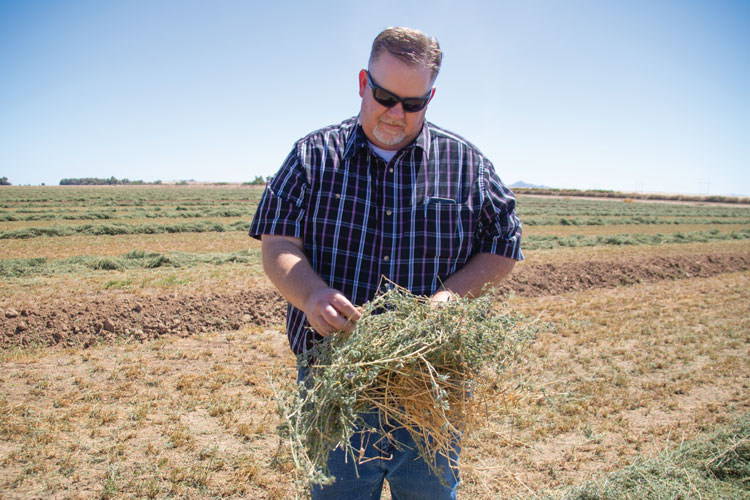Vying for water in the valleys |
| By Amber Friedrichsen, Associate Editor |
|
Hay producers in Southern California — and the rest of the Colorado River Basin — struggle to find balance between conserving water and maximizing forage yields. |
 Hay producers in Southern California — and the rest of the Colorado River Basin — struggle to find balance between conserving water and maximizing forage yields.
When Ronnie Leimgruber’s grandfather came to America from Switzerland in 1910, he settled in the Imperial Valley of Southern California. He purchased land, claimed water rights, and started milking dairy cattle by hand. Hundreds of other small-scale dairymen in the Imperial Valley did the same until urbanization along the coast pulled cow herds and milk processing plants in the same direction. Then, the desert farmers started making hay. As land passed from one generation to the next, so did the water rights Leimgruber’s grandfather held. In fact, the entire valley is a grid of various shades of green despite being surrounded by a bone-dry desert because of irrigation water from the Colorado River. California — along with Colorado, Wyoming, Utah, New Mexico, Arizona, and Nevada — comprise the Colorado River Basin and adhere to the prior appropriation system, which protects senior water rights of settlers according to a first come, first serve basis. Most of the water rights are still being used for agricultural production like they were a century ago, but the laws that were once set in stone seem more and more to be written in sand. “We haven’t changed the number of acres we are farming since they allocated the river water in the early 1920s,” Leimgruber said, driving alongside his alfalfa fields, monitoring his flood irrigation systems. However, the ongoing drought across the West, unpredictable snowpack in the Sierra Nevada Mountains, and a rising population in major cities are just a few of the factors making it difficult to secure the water supply he needs to sustain his commercial hay operation. It’s all irrigated Leimgruber owns about 2,500 total acres of farmland, including nearly 1,500 acres of alfalfa, 500 acres of bermudagrass, and 500 acres rotated to vegetables like carrots, onions, and lettuce. The family business near the small town of Holtville is anchored in hay and forage, but the rotation crops are also critical to our nation’s food supply. Roughly 90% of the United States’ leafy greens are produced in the Imperial and Yuma Valleys. In an area that receives less than 2 inches of rainfall annually, irrigation water is the crux of production. “It never freezes, so we never stop growing, and that means I have to apply about 120 inches of irrigation water in order to make hay,” Leimgruber said. Those 120 inches of water translate to about 6 acre-feet per year. It is managed by the Imperial Valley Irrigation District and flows to his flood-irrigated fields via cement canals that shoulder the county roads. Alfalfa in particular receives pushback in the West because of its perceived high water usage; however, alfalfa yields in the Lower Colorado River Basin states are among the best in the country, and the forage’s water-use efficiency outshines other crops on a yield per water unit basis. For example, Leimgruber typically makes 10 cuttings of alfalfa every year, getting 8 to 14 tons of forage per acre, depending on the specific characteristics of a stand. According to the USDA’s National Agricultural Statistics Service, the national yield for alfalfa and alfalfa mixtures was slightly more than 3 tons per acre in 2022. Leimgruber harvests hay about every 26 days most of the year and flood irrigates fields two times between cuttings. He slows his harvest schedule to roughly every 35 days when temperatures hit triple digits in the summer. During this oppressive stretch, it takes less than 24 hours for forage to dry down to 10% to 12% moisture.  Ronnie Leimgruber opens a cement valve to flood irrigate one of his alfalfa fields near Holtville.
With the help of eight full-time employees, including his oldest son and daughter, Leimgruber makes large square bales of alfalfa hay that are shipped across the Arizona state line and exported to Middle Eastern countries for dairy cattle. He also makes 95-pound small square bales of alfalfa and bermudagrass hay to sell as retail horse feed. There are about 750,000 horses within a 200-mile radius of his farm, and his customers in this branch of the business expect consistent service and supreme forage quality. Efficiency inquiries In addition to flood irrigation, Leimgruber has installed sprinkler irrigation systems in four of his alfalfa fields with funding from the Environmental Quality Incentives Program (EQIP). Sprinkler irrigation has been shown to be more water efficient than flood irrigation, and the Imperial Valley Irrigation District compensates farmers who implement the former strategy to encourage water conservation. Leimgruber saves about 1 acre-foot of water a year with each of his sprinkler systems, and he has noticed higher alfalfa yields on these fields. With that said, the sprinklers operate about 20 days a month, and considering the infrastructure and inputs required, he often contemplates the true meaning of efficiency. “How do you measure efficiency?” the inquisitive alfalfa producer asked. “These sprinkler systems run for 4,000 hours, use about 5,000 gallons of diesel, have about a mile of galvanized piping, and have over 1,000 plastic hoses and regulators. When we flood irrigate, it just takes an irrigator, a cement canal, and some cement valves.” Deficit irrigation is another concept that has crept across the Imperial Valley as the three states that comprise the Lower Colorado River Basin — California, Nevada, and Arizona — have signed a memorandum of understanding to conserve 3 million acre-feet of Colorado River water through 2026. California alone has agreed to save 1.5 million acre-feet of water over the next three years to try to maintain water levels in the river, as well as Lake Powell and Lake Mead, which are formed by the Glen Canyon Dam and the Hoover Dam, respectively. One strategy farmers can implement to achieve this goal involves not irrigating alfalfa fields from July 1 through September 1 when plants require more water to survive the stifling desert weather. Although alfalfa goes dormant due to the break in irrigation, it fully recovers when it is watered again. Nonetheless, Leimgruber is prudent to the impacts this practice will have on his overall production. “We probably won’t do deficit irrigation on our first-year alfalfa stands because you can get pretty good production from them in the summer and it might not pay off,” Leimgruber said about growing forage in 2024. “Depending on what the price of hay is, we will probably do it on our second-, third-, and fourth-year stands, but we will lose about 2 tons of alfalfa to the acre.” Palo Verde perspective Ninety miles northeast of the Imperial Valley is the Palo Verde Valley where farmers face similar trials and tribulations regarding irrigation. The considerably smaller irrigation district also incentivizes deficit irrigation, but alfalfa producers like Brad Robinson still feel fingers pointing at them for continuing to grow the perennial legume. “Alfalfa is the devil according to a lot of people because it uses so much water, but it is necessary for feeding cows and sheep and horses,” said the third-generation farmer from Blythe. “We are still using the same amount of water we used 60 years ago. Nothing has changed here. What has changed is the number of other people who want the water.” Robinson’s property, as well as the rest of the Palo Verde Valley, is unique in that the landscape naturally slopes to the south. Because of this, drainage ditches have been installed to collect irrigation water once it has flooded fields and percolated through the soil. The water is recycled back to the Colorado River, which borders the eastern edge of the valley, but despite the lower irrigation rates achieved by this return flow system, water supplies in the area remain low.  Despite the arid climate, hay producers like Brad Robinson boast some of the best alfalfa yields in the country.
Fallowing fields is one way Robinson saves water, although the number of acres that sits idle varies from year to year. He has about 1,000 acres in alfalfa at any given time, and he also grows bermudagrass, teff grass, and a three-way mix of oats, wheat, and barley for dry hay. Robinson rotates these forages with cotton, corn, wheat, and several varieties of melons, and he is part of a program where he can conserve up to 35% of his irrigation water a year by fallowing fields for financial compensation. In the summer of 2023, he did so on about 700 of his 3,100 total acres. “The past two years, we did some additional fallowing that kept water in Lake Mead,” Robinson said. “It probably would have been better off to farm it because hay prices were sky high, but for the sake of the river, we ended up fallowing.” In his actively growing alfalfa stands, Robinson harvests hay seven to nine times a year and achieves average yields between 7 and 8 tons of forage per acre. He cuts forage every 32 days in February, March, and April, and then extends this period to about every 36 days to accommodate slower plant growth in the summer. Each field is usually watered two to three times between cuttings with a gravity fed irrigation system, and Robinson adjusts irrigation rates according to the soil properties in a field. He also strategically manages his harvest schedule to maximize water use on every acre. “We have alluvial soils because of how the river naturally flowed through here, so I could have sandy soil on one end of the field and heavy clay on the other,” he said. “I typically cut about 80 to 90 acres of hay a day because I don’t want to try to water hundreds of acres all at once. Every field has its own cycle — its own rotation.” Like Leimgruber, Robinson makes large square bales of alfalfa hay for dairy cattle and small square bales of alfalfa and bermudagrass hay for horses with the help of about 25 full-time employees. Most of his hay is distributed domestically, including to racetracks in Florida where equine owners praise its high quality and palatability. Hopes and fears Even though Robinson primarily takes part in the national market, a small percentage of his early hay cuttings is sold overseas. Other farmers in the area make more significant contributions to export sales, which fuels the fire against using water to grow alfalfa that is shipped to other countries. Another argument opposing agricultural water use in the Colorado River Basin is that alfalfa should be grown in regions with ample annual rainfall, but doing so would drastically dampen the forage’s yield potential. Relocating alfalfa acres would consequently disrupt shipping logistics and intensify transportation costs, and Robinson fears doing so would negatively affect our nation’s food supply. “It’s going to take twice the amount of acreage to grow alfalfa in other areas and produce what we produce here,” he said. “If we put a million alfalfa acres in the northern part of the country, those million acres have to come out of some other sort of production.” Robinson believes in the mission to conserve water from the Colorado River, but the best ways to implement advanced irrigation technologies, promote deficit irrigation, and incentivize fallowing programs are still unclear. What is clear, though, is his steadfast stewardship that is rooted in a desire for collaboration between crop producers and water consumers that will benefit the future of his farm and the industry as a whole. “Every valley is different, and every farmer has different circumstances. There is no one-size-fits-all solution,” Robinson asserted. “It’s hard to plan for anything. I just have to see what happens and make changes so the farm stays profitable, and so I can hopefully continue what generations before me did and hand the next generation a ranch that is better than the ranch that was handed to me.” This article appeared in the November 2023 issue of Hay & Forage Grower on pages 6-8. Not a subscriber? Click to get the print magazine. |
